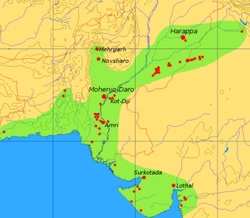Alamgirpur
Alamgirpur | |
|---|---|
Archeological site | |
| Country | India |
| Province | Uttar Pradesh |
| Time zone | UTC+5.30 (Indian Standard Time) |
Alamgirpur (Hindi: अलाम्गिरपुर) is an archeological site of the Indus Valley Civilization that thrived along Indus River (c. 3300–1300 BC) from the Harappan-Bara period, located in Meerut district, Uttar Pradesh, India.[1][2] It is the eastern most site of the civilization.[3]
Historical significance
This site was also called Parasaram-ka-khera.
Excavation
The site was partially excavated in 1958 and 1959 by Archeological Survey of India.[2]
Period I
On excavation, the site showed four cultural periods with interevning breaks; the earliest of them represented by a thickness of 6 feet, belonged to Harappan Culture.[4] Although kiln burnt bricks were in evidence, no structure of this period was found, probably due to the limited nature of the excavations.[4] Brick sizes were, 11.25 to 11.75 in. in length,5.25 to 6.25 in. in breadth and 2.5 to 2.75 in.in thickness; larger bricks averaged 14 in. x 8 in.x 4 in. which were used in furnace only.[4]
Artefacts found
Typical Harappan pottery was found and the complex itself appeared to be a pottery workshop. Ceramic items found included roof tiles, dishes, cups, vases,cubicle dice, beads,terrecotta cakes, carts and figurines of a humped bull and a snake.[4] There were also beads and possibly ear studs made of steatite paste, faience, glass, carnelian, quartz, agate and black jasper. Little metal was in evidence. However, a broken blade made of copper was found.[5]
Other findings
The head of a bear (?) being a part of a vessel was discovered at Alamgirpur.[4] A small terrecotta bead-like structure was coated with gold.[4] Evidence of cloth is found in way of impressions on a trough; yarn used for cloth looked fairly fine and weaving method used is "plain weave".[4]
Period II
The gap between Period I and Period II was represented by textural composition of layers in addition to their respective cultural assemblage. Deposits belonging to Period I were compact and brownish. That of Period II was loose and grey with frequent bands of burnt earth and ash. Although kiln burnt bricks were in evidence, no structure of Harappan period was found, probably due to the limited nature of the excavations.[4]

Importance
Discovery of Harappan culture at Alamgirpur enormously enlarged the horizon of Indus Valley Civilisation in the eastern direction, in India.[4]
Four periods of Alamgirpur respectively belonged to (I) Harappan, (II) Painted Grey Ware (III) Early historical and (IV) Late Medieval Period.[6]
See also
- Bhagatrav
- Manda, Jammu northern most IVC site
- Sutkagan Dor western most IVC site
References
- ^ The Encyclopedia of Indian Archeology, by A. Ghosh.
- ^ a b A. Ghosh (ed.). "Excavations at Alamgirpur". Indian Archaeology, A Review (1958-1959). Delhi: Archaeol. Surv. India. pp. 51–52.
- ^ Map
- ^ a b c d e f g h i India, Archeological Survey of. "India Archeology 1958-59" (PDF). Ed : Amalanada Gosh. Archeological Survey of India. pp. 51–52. Retrieved 3 July 2012. Cite error: The named reference "asi" was defined multiple times with different content (see the help page).
- ^ Singh, Upinder (2008). A history of ancient and early medieval India : from the Stone Age to the 12th century. New Delhi: Pearson Education. p. 214. ISBN 9788131711200.
- ^ India, Archeological Survey of. "India Archeology 1958-59" (PDF). Ed : Amalanada Gosh. Archeological Survey of India. p. 55. Retrieved 3 July 2012.
External links
Map of Indus Valley Civilisation (Late Harappan) sites [1]
